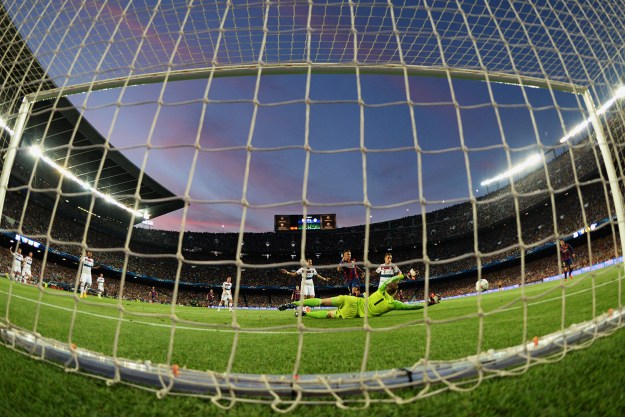Five films are nominated for an Academy Award in the “Visual Effects” category this year, and they each offer a nice look at the amazing tricks filmmakers and their effects teams can pull off on the big screen. In recognition of these five films and one of our favorite Oscar categories, we’re putting the spotlight on one “Visual Effects” nominee each day leading up to Sunday’s broadcast and taking a closer look at what made them stand out.
Previously, we looked at the face-mapping effects in Captain America: The Winter Soldier, the mobile motion-capture technology of Dawn of the Planet of the Apes, and the digitally created duo that were the breakout stars of Marvel’s Guardians of the Galaxy. Now, we look at the way Interstellar won over the scientific community by bringing the most accurate black hole ever seen to the big screen.
In most cases, the bulk of visual-effects work in cinema takes place during filming and – even more frequently – after principle photography has taken place. Backgrounds are added or removed, images and figures are mapped to actors’ performances, and various other aspects of VFX production clean up, spice up, and otherwise finish the film.
However, in the case of Christopher Nolan’s sci-fi drama Interstellar, one of the most impressive visual-effects elements of the film – the massive black hole known as Gargantua – went into production well before the cameras began rolling.
Hollywood is no stranger to using black holes as plot devices, but in most cases, the visual spectacle has often trumped the science behind the cosmic phenomena. This left Nolan and his team with a unique problem: How to accurately present on the screen a region of space and time that defies visual representation?
No existing visual-effects software was capable of providing an accurate image of a black hole.
The answer, of course, involved computers. Lots of them. It also involved renowned Caltech astrophysicist Kip Thorne.
“During pre-production, Chris called me into his office,” recalled Paul Franklin, the film’s visual-effects supervisor and founder of VFX studio Double Negative, in a December 2014 interview with Space.com. “He said ‘You’ve got to go and see this guy – it’s going to be really important to the visual effects process.’ So I went over to Kip’s house. I already knew who he was – I’m very interested in these sorts of things, and Kip is one of the great physicists of the modern era. But it also turned out he was an amazing communicator. He gave me a crash course in space time and wormholes, and told me there were a lot of misconceptions about what these things should like like.”
What Franklin learned from the celebrated scientist was that much of the typical Hollywood representation of black holes as swirling whirlpools in space was inaccurate. Not only are black holes actually three-dimensional spheres in space devoid of any light, but they’re also surrounded by discs of glowing gas and dust created by the black hole’s intense gravity, which distorts light, space, and yes, even time.
Thorne, who served as both the film’s scientific consultant and executive producer, provided copious notes to Franklin’s team about the nature of black holes and what they would theoretically look like to someone traveling close enough to see one through, say, the window of a spacecraft carrying humanity’s only hope for salvation. What the VFX team soon realized was that no existing visual-effects software was capable of providing an accurate image of a black hole.
“I saw some very basic simulations that had been done by the scientific community and I thought, ‘Well, the movement of this thing is so complex, maybe there’s something we can do ourselves and implement our own version of this,’” Franklin told FX Guide. “Kip then worked very closely with the R&D at Double Negative, particularly with Oliver James, our chief scientist, to take Kip’s equations that he’d worked out to calculate all of the light paths – the ray-tracing paths – around the black hole. And then Oliver worked out how to implement that in a new renderer we called DnGR – which stands for Double Negative General Relativity.”
This entirely new rendering software allowed the visual-effects team for Interstellar to create the most high-resolution image of a black hole in motion ever seen on the screen, or by the existing academic community. According to Wired, some of the individual frames created for the simulation took up to 100 hours to render, resulting in a finished movie that approached 800TB of data.
In the end, the resulting software created by Double Negative broke as much ground in the visual-effects world as it did in the scientific world, and prompted the VFX team to publish a paper detailing their findings in the scientific journal Classical and Quantum Gravity.
Some of the individual frames created for the simulation took up to 100 hours to render.
“Interstellar is the first Hollywood movie to attempt depicting a black hole as it would actually be seen by somebody nearby,” wrote the authors of the paper, which describes the way in which the team used Thorne’s equations to map the path of light around a black hole.
It took until the final weeks of pre-production on the film for Double Negative to put the finishing touches on its new black-hole rendering software, but the cast of the film is likely to insist the time was well-spent.
In an effort to minimize the use of green-screen effects, Nolan projected the images created by the rendering software just outside the windows of the spacecraft piloted by Matthew McConaughey’s character in the film – giving the cast the experience of seeing what people in their position would actually see when they gazed upon a black hole or the very first time.
“We took this high powered digital projector – the kind of projector you use in modern cinemas – and had them mount it on a huge forklift truck,” recalled Franklin in an interview with The Telegraph. “We could move these around the set, and position them so that they would throw an image on to a vast cinema screen, which we built outside the set. It was 80 feet high, and 300 feet long – so it was the size of several tennis courts, edge to edge.”
“It meant that during filming, the actors had a real image outside the spacecraft window,” he explained. “They loved it – they all came to us afterwards and said how it helped them really put themselves into this extraordinary world we were asking them to imagine. Anne Hathaway was so astonished by this image of the wormhole coming towards the spacecraft, she told me it almost made her forget her lines at one point.”
And with Interstellar now in the running to take home an Academy Award for its visual effects, Hathaway clearly isn’t the only person to be impressed by the product of the Interstellar VFX team’s efforts. In fact, there’s a very real possibility that the film’s legacy will extend far beyond what’s seen on the screen.




